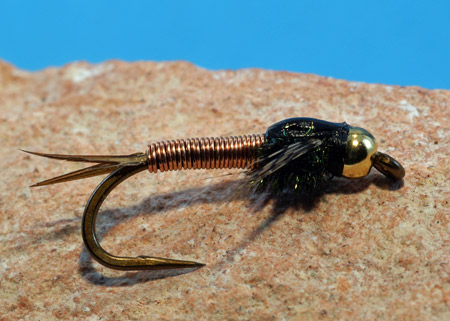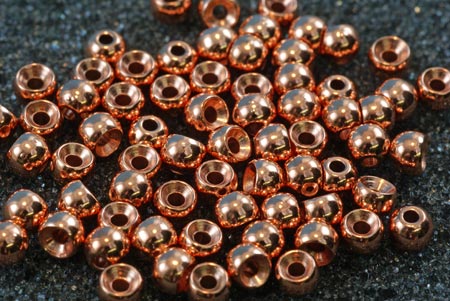 |
| John Barr's Copper John, a perfect blend of wire, lead and bead. | It’s early July and for many fly fishers it is time to exorcise the dry fly demons that have accumulated since this time last season. Caddis should in full scamper and your local rivers should now be open for business. Although generally sunny and warm some rivers and streams may still be suffering the effects of seasonal run off. Dry fly opportunities may be limited. In most cases, like it or not, bouncing and swinging weighted nymphs through the deep swift runs is often a better bet. With trout feeding up to ninety percent of their time beneath the surface dry fly might be seen as the low end of the spectrum at the best of times. Still it is tough to beat the visible swirl of a trout to the fly, my personal introduction into this magnificent sport is well entrenched in this vision.
Amidst the bubbles, refracted light and current trout can’t and quite often won’t move far for an offering not in their strike zone. In order to successfully plumb the rubble within a stream nymph patterns need to be weighted in order to do their job. Weighting a fly is often the first step in tying as the balance of the fly is constructed around whatever mode of mass is selected.
The first method available to the fly tier for adding weight is lead wire substitute. Sold on spools in diameters ranging from .010" to in excess of .035" lead wire is an easy material to work with. Placing the lead wire onto a wide barreled floss bobbin makes this operation even simpler, simply wind the lead wire onto the hook shank as though it was tying thread. Once the desired amount of lead is in place pinch of the lead using the thumbnail. If the evening’s tying calls for a dozen or so flies complete this step on all hooks prior to proceeding, it knocks minutes off the finish time. As for what size lead wire to choose is? Use the hook shank diameter as a guide, the larger the hook diameter the larger the lead wire. Of course specific fishing conditions play an important role as well. Once wound on the shank the lead wire creates a natural drop off that must be managed. Left unattended this drop off can become a royal pain. Take the time to lock the lead into place with tying thread by creating thread ramps fore and aft of the lead. For larger patterns try substituting dubbing for thread for quicker results. Some fly patterns such as mayfly nymphs need to be weighted and skinny, a fly tying oxy moron of sorts. One method is to take a length of lead wire and squash it flat using a pair of flat nose pliers and then tying it in place on top of the hook shank as a first step. X-Ray lead or wine bottle lead is an excellent source of already flattened lead. Don’t forget a dab of red nail polish or model paint at the hook eye to quickly identify weighted from un-weighted patterns. Amongst the jumble that is most fly boxes weighted and un-weighted soon become inseparable.
There are many interesting curved shank hooks available to fly tiers today but for those contemplating heavy patterns they need to be cognizant of the "keel effect". Weighted curved style hooks now have their center of gravity at their highest point the apex of the curved shank and as a result roll upside down when put into action. This effect shouldn’t negate the use of curved hooks and actually can be incorporated into the fly’s design to help make it snag resistant enabling one to crawl the crevices where trout prefer to lie. Simply tie the pattern upside down, a great strategy for bouncing obese stonefly dressings through deep rubble.
 |
| Beads have become a welcome supplement to just about every nymph pattern. | Besides the somewhat traditional lead wire approach there are other hefty alternatives to consider. Since their introduction from Europe metal beads have been a welcome supplement to just about every nymph pattern. Every popular common nymph has benefited from a bead head. The Gold Ribbed Hare’s Ear and the Pheasant Tail are just two that come to mind. Depending upon the stream or river depth and current speed fly tiers have the choice of brass, lead or tungsten beads. Besides the weight the color of the bead can also be incorporated in the patterns design as an attraction point or to simulate the trapped air and gases many insects use during their emergence accent. Metal beads are easy to slide onto the hook shank and because their weight is evenly dispersed around the hook the keel effect isn’t a concern.
To view the rest of this article, please login or join now for free!
| 


